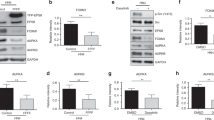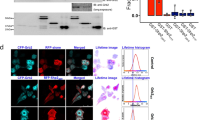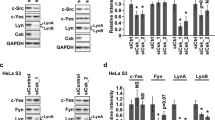Abstract
ShcC is a family member of the Shc docking proteins that possess two different phosphotyrosine-binding motifs and conduct signals as Grb2-binding substrates of various receptor tyrosine kinases. We have recently shown that some neuroblastoma cell lines, such as NB-39-nu cells, express a protein complex of hyperphosphorylated ShcC and anaplastic lymphoma kinase (ALK), which is self-activated by gene amplification. Here, we demonstrate that the expression of a mutant ShcC lacking Grb2-binding sites, 3YF-ShcC, significantly impaired the survival, differentiation and motility of NB-39-nu cells by blocking the ERK and Akt pathways. On the other hand, cells overexpressing ShcC or 3YF-ShcC, but not a mutant ShcC that lacks SH2, showed decreased anchorage independency and in vivo tumorigenicity, suggesting a novel ShcC-specific suppressive effect through its SH2 domain on cell transformation. Notably, overexpression of ShcC suppressed the sustained phosphorylation of Src family kinase after cell detachment, which might be independent of phosphorylation of Grb2-binding site. It was indicated that the Src/Fyn-Cas pathway is modulated as a target of these suppressive effects by ShcC. Reciprocal change of ShcC expression and phosphorylation observed in malignant neuroblastoma cell lines might be explained by these phosphotyrosine-dependent and -independent functions of ShcC.
This is a preview of subscription content, access via your institution
Access options
Subscribe to this journal
Receive 50 print issues and online access
$259.00 per year
only $5.18 per issue
Buy this article
- Purchase on Springer Link
- Instant access to full article PDF
Prices may be subject to local taxes which are calculated during checkout







Similar content being viewed by others
References
Andrechek ER, Hardy WR, Siegel PM, Rudnicki MA, Cardiff RD and Muller WJ . (2000). Proc. Natl. Acad. Sci. USA, 97, 3444–3449.
Collins LR, Ricketts WA, Yeh L and Cheresh D . (1999). J. Cell Biol., 147, 1561–1568.
Folkman J and Moscona A . (1978). Nature, 273, 345–349.
Freedman VH and Shin SI . (1974). Cell, 3, 355–359.
Frisch SM and Francis H . (1994). J. Cell Biol., 124, 619–626.
Gavrieli Y, Sherman Y and Ben-Sasson SA . (1992). J. Cell Biol., 119, 493–501.
Giancotti FG . (1997). Curr. Opin. Cell. Biol., 9, 691–700.
Gu J, Tamura M, Pankov R, Danen EH, Takino T, Matsumoto K and Yamada KM . (1999). J. Cell Biol., 146, 389–403.
Honda H, Nakamoto T, Sakai R and Hirai H . (1999). Biochem. Biophys. Res. Commun., 262, 25–30.
Honda H, Oda H, Nakamoto T, Honda Z, Sakai R, Suzuki T, Saito T, Nakamura K, Nakao K, Ishikawa T, Katsuki M, Yazaki Y and Hirai H . (1998). Nat. Genet., 19, 361–365.
Iwahara T, Fujimoto J, Wen D, Cupples R, Bucay N, Arakawa T, Mori S, Ratzkin B and Yamamoto T . (1997). Oncogene, 14, 439–449.
Kumar CC . (1998). Oncogene, 17, 1365–1373.
McNeil PL, McKenna MP and Taylor DL . (1985). J. Cell Biol., 101, 372–379.
Miyake I, Hakomori Y, Shinohara A, Gamou T, Saito M, Iwamatsu A and Sakai R . (2002). Oncogene, 21, 5823–5834.
Morris SW, Naeve C, Mathew P, James PL, Kirstein MN, Cui X and Witte DP . (1997). Oncogene, 14, 2175–2188.
Nakamura N, Chin H, Miyasaka N and Miura O . (1996a). J. Biol. Chem., 271, 19483–19488.
Nakamura T, Sanokawa R, Sasaki Y, Ayusawa D, Oishi M and Mori N . (1996b). Oncogene, 13, 1111–1121.
O'Bryan JP, Martin CB, Songyang Z, Cantley LC and Der CJ . (1996a). J. Biol. Chem., 271, 11787–11791.
O'Bryan JP, Songyang Z, Cantley L, Der CJ and Pawson T . (1996b). Proc. Natl. Acad. Sci. USA, 93, 2729–2734.
Parsons JT and Weber MJ . (1989). Curr. Top. Microbiol. Immunol., 147, 79–127.
Pawson T, Gish GD and Nash P . (2001). Trends Cell Biol., 11, 504–511.
Pelicci G, Dente L, De Giuseppe A, Verducci-Galletti B, Giuli S, Mele S, Vetriani C, Giorgio M, Pandolfi PP, Cesareni G and Pelicci PG . (1996). Oncogene, 13, 633–641.
Pelicci G, Lanfrancone L, Grignani F, McGlade J, Cavallo F, Forni G, Nicoletti I, Pawson T and Pelicci PG . (1992). Cell, 70, 93–104.
Pelicci G, Troglio F, Bodini A, Melillo RM, Pettirossi V, Coda L, De Giuseppe A, Santoro M and Pelicci PG . (2002). Mol. Cell. Biol., 22, 7351–7363.
Rozakis-Adcock M, Fernley R, Wade J, Pawson T and Bowtell D . (1993). Nature, 363, 83–85.
Sakai R, Henderson JT, O'Bryan JP, Elia AJ, Saxton TM and Pawson T . (2000). Neuron, 28, 819–833.
Sakai R, Iwamatsu A, Hirano N, Ogawa S, Tanaka T, Mano H, Yazaki Y and Hirai H . (1994). EMBO J., 13, 3748–3756.
Sidell N, Altman A, Haussler MR and Seeger RC . (1983). Exp. Cell Res., 148, 21–30.
Stevenson LE, Ravichandran KS and Frackelton Jr AR . (1999). Cell Growth Differ., 10, 61–71.
Thomas D and Bradshaw RA . (1997). J. Biol. Chem., 272, 22293–22299.
van der Geer P, Wiley S, Gish GD and Pawson T . (1996). Curr. Biol., 6, 1435–1444.
van der Geer P, Wiley S, Lai VK, Olivier JP, Gish GD, Stephens R, Kaplan D, Shoelson S and Pawson T . (1995). Curr. Biol., 5, 404–412.
Wang Y and Sheibani N . (2002). J. Cell. Biochem., 87, 424–438.
Wary KK, Mainiero F, Isakoff SJ, Marcantonio EE and Giancotti FG . (1996). Cell, 87, 733–743.
Wary KK, Mariotti A, Zurzolo C and Giancotti FG . (1998). Cell, 94, 625–634.
Wei L, Yang Y, Zhang X and Yu Q . (2002). J. Cell. Biochem., 87, 439–449.
Weng Z, Thomas SM, Rickles RJ, Taylor JA, Brauer AW, Seidel-Dugan C, Michael WM, Dreyfuss G and Brugge JS . (1994). Mol. Cell. Biol., 14, 4509–4521.
Windham TC, Parikh NU, Siwak DR, Summy JM, McConkey DJ, Kraker AJ and Gallick GE . (2002). Oncogene, 21, 7797–7807.
Acknowledgements
This study was supported by the Program for Promotion of Fundamental Studies in Health Sciences of Organization for Pharmaceutical Safety and Research of Japan, and was also supported by a grant from SBS, Inc. Izumi Miyake is the recipient of Research Resident Fellowships from the Japan Health Sciences Foundation.
Author information
Authors and Affiliations
Corresponding author
Additional information
Supplementary Information accompanies the paper on Oncogene website (http://www.nature.com/onc)
Supplementary information
Rights and permissions
About this article
Cite this article
Miyake, I., Hakomori, Y., Misu, Y. et al. Domain-specific function of ShcC docking protein in neuroblastoma cells. Oncogene 24, 3206–3215 (2005). https://doi.org/10.1038/sj.onc.1208523
Received:
Revised:
Accepted:
Published:
Issue Date:
DOI: https://doi.org/10.1038/sj.onc.1208523
Keywords
This article is cited by
-
Phosphorylation of RasGRP1 by Shc3 prevents RasGRP1 degradation and contributes to Ras/c-Jun activation in hepatocellular carcinoma
Molecular and Cellular Biochemistry (2023)
-
Shc3 promotes hepatocellular carcinoma stemness and drug resistance by interacting with β-catenin to inhibit its ubiquitin degradation pathway
Cell Death & Disease (2021)
-
miR-99b-targeted mTOR induction contributes to irradiation resistance in pancreatic cancer
Molecular Cancer (2013)
-
Mechanistic insight into ALK receptor tyrosine kinase in human cancer biology
Nature Reviews Cancer (2013)
-
Genome-wide analysis of genetic alterations in Barrett's adenocarcinoma using single nucleotide polymorphism arrays
Laboratory Investigation (2009)



